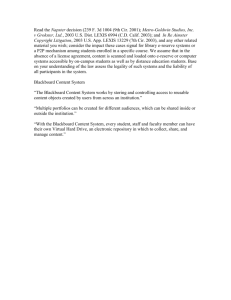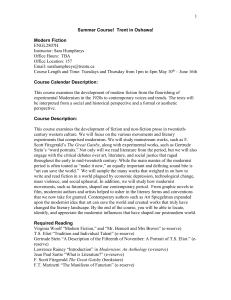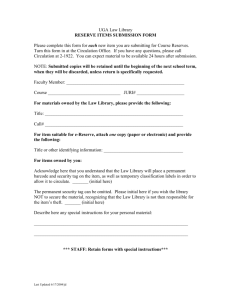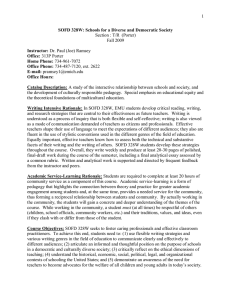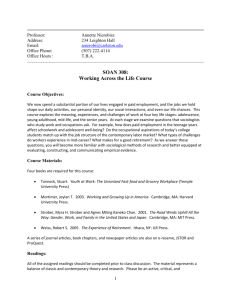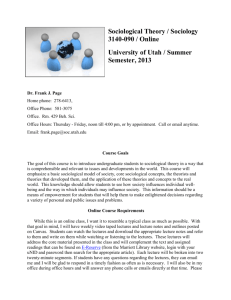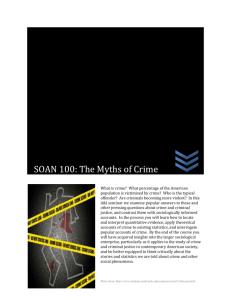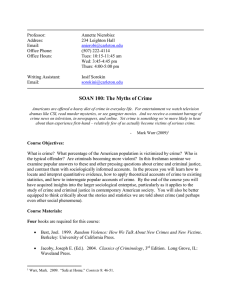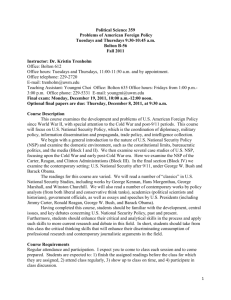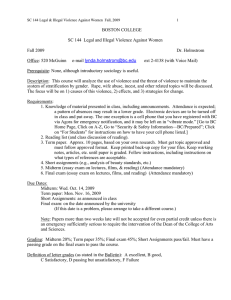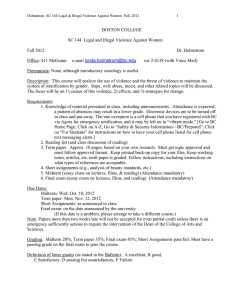Practical Approaches to Digital Copyright
advertisement
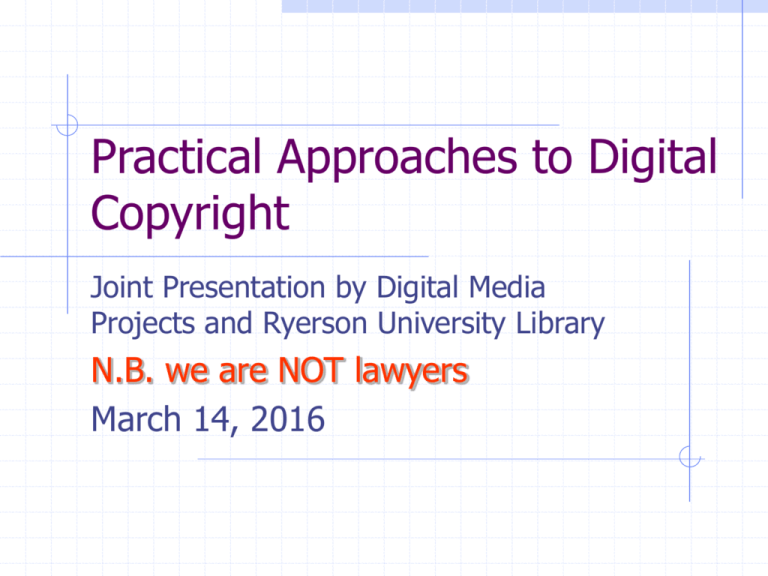
Practical Approaches to Digital Copyright Joint Presentation by Digital Media Projects and Ryerson University Library N.B. we are NOT lawyers March 14, 2016 Overview Digital copyright basics Images, photos and films Video streaming Text based materials Protecting your own work from breach of copyright What does copyright protect? Exclusive right to copy Includes the right to: Duplicate, Scan or Digitize Show in public Broadcast Adapt Translate What else does copyright protect? Economic Rights Moral Rights Protect the integrity of the work Protect the right to be associated with the work Stay with the author, even when work is licensed to others Copyright. What is it? To be protected by copyright the work must be both ORIGINAL and tangibly FIXED Copyright does not apply to IDEAS; Copyright applies to the form of their communication Your work does NOT need to be registered to be protected by copyright it is protected by the Canadian Copyright Act once it is created in a fixed form What is digital copyright? How we exploit copyright material affects how we obtain copyright permission Paper-to-paper uses fall under Access Copyright Digital distribution: must obtain direct permission, Access Copyright does not apply Streaming videos & DVDs: library’s public performance rights do not apply What can I use? What can’t I? OK, go right ahead: Public Domain and Copyright-free materials (check disclaimers carefully) Licensed materials from the library Your own creations OK, if you get permission: All other copyright materials What can I use? Licensed materials from the Library ARTstor over 500,000 (and growing) images cross-disciplinary, including maps, photographs, and construction images, as well as art designed specifically for the academic environment (nonprofit) stable URL so can be linked through E-Reserve, web pages or Blackboard users can create own image groups which can be put into private or public folders folders created by instructors can be hidden and password protected. What can I use? Licensed materials from the Library ARTstor Also includes presentation software presentations can be done on-line, or off-line through “image viewer” images (non ARTstor as well) can be input into image viewer, and additional data added instructors can add own lecture notes, student can add notes which can be only visible to them or can be made visible to others. local collections can be added for access only to the institutions own community or to all of ARTstor users Screen shots What can’t I use…as easily? Copyright in Photographs generally, “author” of photograph holds copyright not necessarily photographer “author” - person who owned negative when made commissioned photo – person ordering holds copyright photo made during employment held by employer What can’t I use…as easily? Copyright in Photographs Term rules generally - author’s life +50 years anonymous photos – least of: publication +50 years or creation +75 years pre-1949 photos are in public domain What can’t I use…as easily? Copyright in Photographs Rights of the photograph’s © holder: Economic Reproduction Exception: educational institutions may make copy of image for projection on the premises – not on web First publication then rights may be assigned elsewhere Communication to the public by telecommunication (e.g. Internet) Public presentation/exhibition What can’t I use…as easily? Copyright in Photographs Rights of the photograph’s © holder: Moral Attribution (or not) Association (with something damaging to reputation) Integrity of work (no changes) Above cannot be assigned to someone else, but can be waived What can’t I use…as easily? Added complications! Images in public domain can still be controlled by an institution under contract law Photograph of architectural work 2 copyrights, 2 owners Sound recordings affected by two or more copyrights Recording itself and the content (e.g. the music) Good news about sound recordings: no PPR needed for class use What can’t I use…as easily? Copyright in Cinematographic Works Ownership The ‘author’ owns copyright Normally, the ‘author’ is the director (for dramatic works), but the Act does not specify Non-dramatic works created before 1994 – copyright is held by owner of the negative at the time it was made A film made during employment is held by the employer Is frequently assigned to distributors Geography matters .. What can’t I use…as easily? Copyright in Cinematographic Works Term rules are much like photographs’ Generally: author’s life +50 years ‘Non-dramatic’ = publication + 50 years Anonymous = least of either publication + 50 or creation + 75 years What can’t I use…as easily? Copyright in Cinematographic Works Rights of the film’s © holder: Economic Reproduction, including any ‘substantial’ part of film (cannot be determined by length) Performance in ‘public’ (i.e. anywhere other than home or domestic setting) Communication to the public by telecommunication (i.e. streaming) What can’t I use…as easily? Copyright in Cinematographic Works We purchase with public performance rights (PPR) Needed for class screening Not the same as rights to digitize or stream Copyright must be requested from distributor to digitize/stream We cannot get permission to stream feature films Current status of video streaming Faculty may request streamed videos for Library-held or newly ordered material via the on-line, multi-purpose E-Reserve request form Permission requests processed through either DE staff or Library AV acquisitions staff All access through Blackboard – preferred by distributors – password protected Costs monitored by and approved by AV Librarian on a case by case basis How can I use text-based materials? E-Reserve A library service that provides Ryerson students with online access to course materials Not available to collaborative program students from other schools Posted inside Blackboard, sometimes within the Library catalogue E-mail reserve@ryerson.ca, use the online form, phone 416 979-5051 How can I use text-based materials? E-Reserve An online alternative to Print Reserve Primarily: direct links to journal articles located in the Library’s electronic subscriptions, from Blackboard The Library will try to obtain copyright permission to scan materials from paper and post them online as PDF files Best suited for supplemental readings: don’t plan on replacing your course pack if it contains a large number of articles or book chapters that require clearance How can I use text-based materials? E-Reserve Remember: Copyright is an issue Our Access Copyright license does not apply to E-Reserve We obtain copyright permission for all of the copyright protected materials we scan for E-Reserve Except: materials in the public domain and whatever we own in licensed, online subscriptions How can I use text-based materials? A few words about clearing copyright To clear copyright we need TIME & MONEY Communicating with rights holders often takes an unpredictably long time Library pays for copyright fees that it can afford Rights holders can ask for ANYTHING – frequently that’s too much Permissions (almost) always apply for specific, limited time & user group It’s important to: plan ahead prepare for the worst Clearing © on your own We will clear © only for materials over which we can retain control and only for materials that are used in conjunction with Ryerson courses. Be careful with your publicly accessible sites. Public i.e. anyone, anywhere in the world We have a sample letter to help you. Other resources Open Access sites Internet Archive http://www.archive.org/ MIT Open Courseware http://ocw.mit.edu/OcwWeb/ Creative Commons http://creativecommons.org/ Useful resources Library’s copyright FAQ A Practical guide on Copyright Clearance for New media Producers from the Department of Canadian Heritage Protecting your own work from breach of copyright Return
